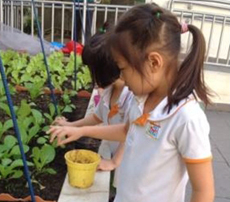Singapore's Rare Pipers

Collecting Piper pedicellosum fruits and cuttings for propagation
Pepper is a common seasoning in our dishes, but did you know that it comes from a unique group of plants known as Pipers?
Pipers belong to the Piperaceae family that usually grows as herbaceous shrubs or creeping climbers. They boast a suite of biochemical compounds that give off a peppery scent, often detectable from a pinch of crushed leaves, which readily betray their familial origins in the field.
The pepper we use in our culinary pursuits is from the Piper nigrum plant. Less familiar is the Piper betle, or Sireh, used in betel chewing and folk medicine, and Piper sarmentosum, or Kadok, a herbaceous bush widely planted as a dense ground cover.
Natives of Singapore
Although originally from India, Piper nigrum has been cultivated in Singapore for over 200 years, and during the height of the spice trade in the 1800s, was one of the most important exports from our shore. It was literally planted throughout the whole island.

Piper nigrum fruits in the Singapore Botanic Gardens.
A less known fact to most is that Singapore also has its own diversity of native Pipers. About 15 – 20 species of Pipers had been recorded or collected in our forests, mostly growing unnoticed in the shady and moist primary forest habitat. With the rapid destruction of forests, first for the agricultural booms of the early 1800s and 1900s, and subsequently for land development, some have not been seen for over a century.
However, native Pipers are still thriving in our nature reserves and some of the more adaptable species such as Piper caninum and Piper pedicellosum can also be found in secondary forest woodlands and parks. To effectively conserve rare Pipers, both in-situ (on site) and ex-situ (off site) activities and measures must be in place.
Conserving a part of our heritage
As part of Singapore's Plant Conservation Strategy, some Piper species are being propagated through cuttings. Propagation through seeds are much more difficult because most climbing Pipers mature slowly and begin to grow reproductive parts only after reaching the sun-baked heights of the forest canopy, making it near impossible to collect the seeds without climbing the trees.
Piper malamiri was recently discovered near the Dairy Farm Nature Park and in Bukit Timah Nature Reserve. Specimens in the Singapore Botanic Gardens' herbarium were collected in the early 1900s by H.N.Ridley from the Bukit Timah area and Bukit Panjang. Thus efforts are now ongoing to propagate this limited native genetic stock to conserve its species.
Habitat-specific species such as Piper macropiper, which occurs in Nee Soon Swamp Forest and isolated swampy spots in MacRitchie forest, are protected in the nature reserves. For Piper muricatum, Piper porphyrophyllum (Tiger's Betel), and another recent discovery Piper curtisii, which have only been found in very small number of individuals in only one or two localities, full protection of their localities within the nature reserve will be critical to ensure their continued survival in our forest. As we work towards enhancing the population size of these rare species, hopefully enough individuals are nurtured to be introduced into other suitable sites.
By Lua Hock Keong

Piper nigrum plants near Eco-Lake in the Singapore Botanic Gardens.

Piper betle, or Sireh, commonly used in betel chewing.

Piper sarmentosum, or Kadok, a commonly used ground cover.

Piper caninum, a small climbing plant with orange-red fruits.

Flowering spike of the Piper pedicellosum.

Fruiting spike of Piper pedicellosum.

Many large climbing Piper plants, such as this Piper flavimarginatum, often climb high up to the forest canopy where there is more sunlight, before growing flowering and fruiting spikes.

Piper malamiri, a recent find in Bukit Timah Nature Reserve.

Piper macropiper, a Piper that specialises in swampy habitats.

Piper muricatum, a rare shrubby Piper species in Singapore.

Piper porphyrophyllum, or Tiger’s Betel, a distinctive but rare Piper in Singapore.

Close-up of the leaves of Piper porphyrophyllum, or Tiger’s Betel.

Studying the Piper curtisii, a recent find in Singapore.
Have views or comments on this article? Let us know via this form. If you would like to give us feedback on any other areas relating to our parks and gardens, please submit via https://www.nparks.gov.sg/feedback





Li-San 6/6/2014 3:36:52 PM